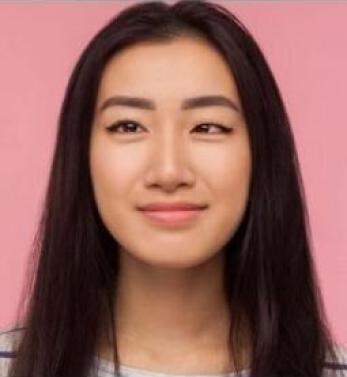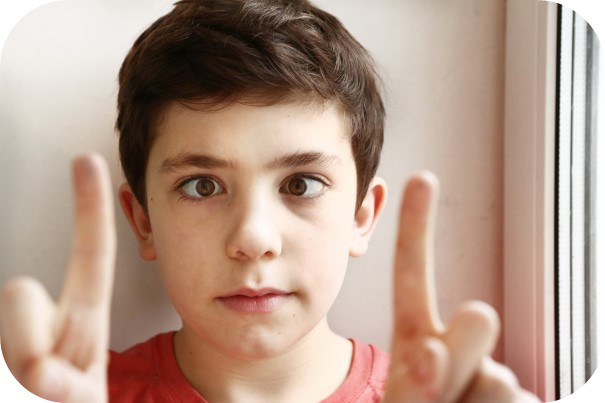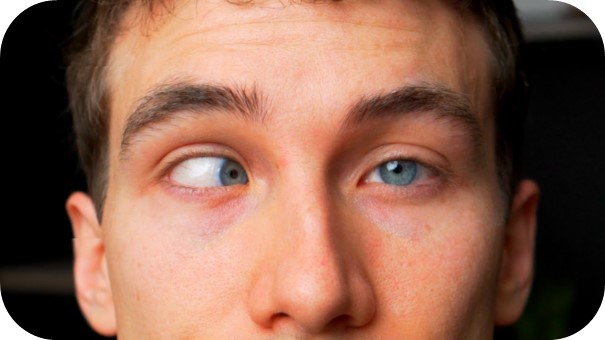





Strabismus is when the eyes are not aligned and looking in different directions. It is a condition where the parallelism is broken in synchronic eye movements.
From birth, children begin to experience visual stimuli from the outside world according to their age. From the first months of life, they begin to develop 3-dimensional vision, which we can also call the sense of depth, by combining the images from both eyes in the visual center of the brain.
At the beginning of this experience period, that is, in the first 3 months of infancy, occasional strabismus is normal. If it continues after the fourth month, it should be considered in terms of eye health.

Reasons
Strabismus is seen in 2-4% of the population. Many factors are thought to play a role in the development of this condition:
There is genetic transmission. The risk is higher in those with a family history of strabismus.
It is more likely to be seen in those with a history of maternal illness during pregnancy, difficult and prolonged birth, preterm birth, postpartum trauma, high fever, and convulsions.
A child with a high eye number may experience a shift in their eyes as they try to see clearly.
Sudden onset of eye shifts is very important. It may be the first herald of intraocular or intracranial masses.
Strabismus may be the first sign of opacification (childhood cataract) in the cornea or lens, which should normally be transparent in the visual axis. In such a case, an eye examination should be performed without delay.
Strabismus can also occur in older ages. When it occurs suddenly in a person who did not have strabismus before, it causes double vision and imbalance in the person. Such a situation may be caused by some systemic diseases such as uncontrolled diabetes or systemic hypertension, as well as intracranial masses and neurological diseases.
Symptoms
A family who notices the following symptoms should definitely bring their child for an eye examination:
Loss of synchronous normal movements of the eyes
squinting one eye, especially in light
The red reflex reflected from the eyes in the photographs turns yellow
Turning the head and/or face in one direction
Imbalance in walking
Significant shifts are easily noticed when viewed from the outside. Small amounts of slippage may be overlooked by the family. This condition, which may result in amblyopia (lazy eye), may therefore be diagnosed late.

Diagnostic Methods
In childhood, the causes of both strabismus and other amblyopia should be checked with routine eye examination.
The full development of the sense of sight in childhood is completed between the ages of 7-10. This age period is very important for us. Any condition that hinders healthy vision development (droopy eyelid, difference between the two eye numbers, congenital cataract, etc.) results in lazy eye.
The earlier the diagnosis is made and the necessary treatment is given, the better the response to treatment. Visual acuity does not increase in treatments performed after this age period.
Routine eye examination should be performed at 6 months, 1 year, 3-3, 5 years, and 6 years of age, without slippage.
Treatment Methods
The choice of treatment method is planned specifically for the patient, according to many variables such as the type of strabismus, the patient's age, and visual acuity.
Strabismus Treatment in Childhood
Strabismus never improves on its own and over time. In some types of strabismus, complete treatment can be provided with the use of glasses. Therefore, the first step of treatment is the correct determination and correction of the need for glasses in the child.
Eye closure treatment with glasses is the treatment that gives good results in cases where visual laziness is accompanied.
How is Eyelid Treatment Applied?
In strabismus, eye closure treatment is planned for the determined periods according to the age of the patient and the depth of the visual laziness.
With adhesive eye closure pads, the eye that sees well is closed at certain times of the day and the patient is provided to use the lazy eye. During the occlusion treatment, the patient should also use their glasses.
At the end of the period recommended by the physician, the amount of increase in visual acuity is determined. The duration of the closure treatment during the day and the time to continue are determined again.
If the slip continues despite the glasses, it may be necessary to perform eye muscle correction surgery. The use of glasses can be continued before and after the surgery. Eye closure treatments should be performed before and after surgery in patients with amblyopia.
Timely diagnosis and treatment of patients with strabismus is very important.
Adult Strabismus Treatment
The initial period of strabismus is taken into account in the treatment in the adult period. New onset strabismus in adulthood is always very important. First of all, the presence of diseases that may cause strabismus should be investigated and these diseases should be treated.
During this period, diplopia (double vision) due to new-onset strabismus negatively affects the patient's quality of life.
In the case of strabismus in adults, a treatment plan is made according to the amount of slippage. With prismatic glasses, Botulinum Toxin (botox) injection into the muscles that move the eye, or strabismus surgery, both the patient's shifting and double vision can be eliminated.
After strabismus surgery in adults, the ability of the adaptation center of the brain to adapt to the new position of the eyes decreases. Therefore, double vision may develop even after surgery. In this regard, preoperative evaluation and informing are very important in terms of suitability for surgery in adults.